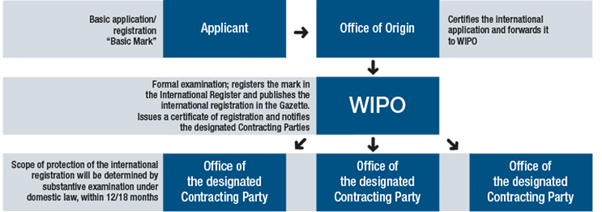Trademark Registration through WIPO
Trademark registration plays a crucial role in protecting the distinctiveness and goodwill associated with a brand or business. While trademarks can be registered nationally, the World Intellectual Property Organisation (WIPO) offers a valuable avenue for international trademark protection.
Trademark registration is the process of securing legal protection for a trademark by filing an application with the appropriate intellectual property office or authority of a country such as IP Australia or United States Patent and Trademark Office. It establishes and confirms the exclusive rights of the trademark owner to use the mark in connection with specific goods or services.
Protecting trademarks on an international scale is crucial for businesses seeking to establish and maintain a global presence. The World Intellectual Property Organization (WIPO) offers a comprehensive framework for trademark registration that simplifies and streamlines the process, enabling businesses to secure their valuable intellectual property rights across multiple jurisdictions.
What is WIPO?
The World Intellectual Property Organisation(WIPO) is a specialised agency of the United Nations dedicated to promoting and protecting intellectual property rights worldwide. WIPO administers various international treaties and provides services to facilitate the protection of trademarks, patents, copyrights, and other forms of intellectual property. There are currently 193 member countries of the World Intellectual Property Organization (WIPO). These countries are part of the WIPO system and may participate in various WIPO-administered treaties and agreements related to intellectual property rights. The list of 193 member states can be found on WIPO’s website https://www.wipo.int/members/en/
Benefits of Trademark Registration with WIPO
- Madrid System for the International Registration of Trademarks allows businesses to file a single application and designate multiple countries for protection. This streamlines the registration process, reducing administrative burdens and costs associated with filing individual applications in each country.
- WIPO’s Madrid System covers a large number of countries, including major economies and key markets. By registering through WIPO, businesses can secure trademark protection in multiple countries simultaneously, facilitating efficient global brand management.
- Registering trademarks through WIPO often proves more cost-effective compared to filing individual national applications across multiple jurisdictions. The centralised system reduces administrative expenses, simplifies renewal procedures, and provides flexibility in managing international trademark portfolios.
Disadvantages of Trademark Registration with WIPO
While trademark registration through the World Intellectual Property Organisation (WIPO) offers several advantages, there are also some potential disadvantages to consider. Here are a few:
- Registering a trademark through WIPO can add up to be quite a costly exercise. Depending on which countries the business wishes to register in, the fees associated with WIPO registration, including application fees and international registration fees, can add up and can be a deterrent for some businesses, particularly small enterprises or startups with limited budgets.
- WIPO offers international trademark registration through the Madrid System, it’s important to note that this system is primarily based on existing national or regional trademark registrations. Consequently, if the initial national or regional registration is invalidated or cancelled, the corresponding international registration could also be affected. This limitation can pose a risk to trademark owners seeking comprehensive protection.
- WIPO registration does not replace the need to comply with individual national or regional trademark examination requirements. After obtaining an international registration through WIPO, trademark owners still need to fulfil specific filing, renewal, and maintenance requirements in each country or region where they seek protection.
- WIPO registration provides protection for your trademark in the designated countries or regions where you seek registration. However, it does not automatically provide protection in countries or regions that are not part of the Madrid System. If you require protection in countries outside the Madrid System, separate applications must be filed directly with the national or regional trademark offices, which can be time-consuming and costly.
How to register a trademark through WIPO
- Before initiating the trademark registration process, it is highly recommended to conduct a comprehensive search to ensure that your proposed mark is not already registered or is similar to existing trademarks. WIPO’s Global Brand Database and other online trademark databases can assist in this search. Conducting due diligence at this stage helps avoid potential conflicts and strengthens the chances of a successful registration.
- Begin the process by filing a basic application with the trademark office of your home country or regional Intellectual Property Office (IPO). This application establishes your priority date and serves as the foundation for international registration through WIPO.
- Within 6 months of filing the home based application, select the Madrid System for the International Registration of Trademarks administered by WIPO. This system allows you to extend trademark protection to multiple countries through a single international application.
- Prepare and submit an international trademark application through the WIPO website or by filing a paper application. Include the necessary information, such as your basic application details, the countries where you seek protection, and the specific class of goods or services associated with your trademark. Submit the required fees for the application. The fee structure may vary depending on the number of classes and countries chosen.
- Within the international application, designate the specific countries where you seek trademark protection. WIPO will forward your application to the respective IP offices of the countries you wish to apply for, for further examination and registration procedures.
- WIPO will conduct a formal examination of your international application to ensure compliance with the necessary requirements. If the application meets the criteria, WIPO will publish the trademark in the WIPO Gazette of International Marks and notify the designated countries.
- Following publication, there is a specific period during which third parties can oppose the registration of your trademark. This period allows interested parties to raise objections based on conflicts with their existing rights. If an opposition is filed, WIPO will assess the claims and decide based on the merits of the case.
- Each designated country will independently examine the international application according to its national laws and regulations. If the country approves the registration, your trademark will be granted protection in that jurisdiction.
- Once your trademark is registered in the designated countries, you must comply with the respective maintenance and renewal requirements.

Practical Takeaways
Although registering your trademark with WIPO offers an efficient and convenient means of protecting your brand globally, the application process is not straightforward, and any mistakes could end up costing you more money in the long run. Further, there is a potential to deal with objections or oppositions from other parties. You will need help to know how to next proceed.
As part of your due diligence, it can also be challenging to perform a thorough global search of your trade mark to make sure it can be registered. To help you save time, remove confusion and prevent avoidable mistakes, our experienced solicitors at Bookmark IP are happy to help you with this process.








